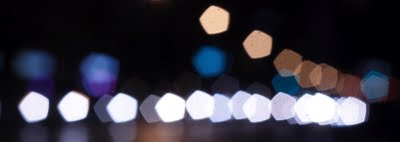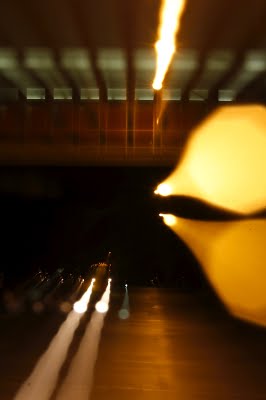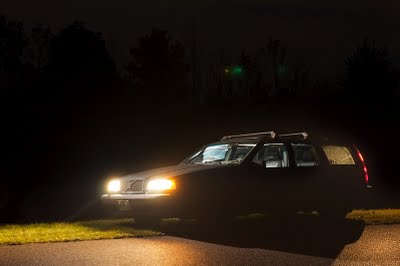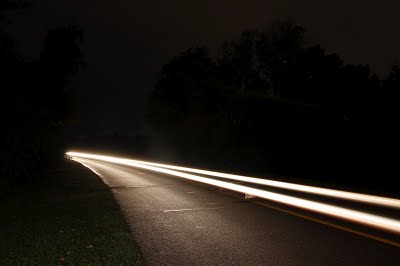From the computer of Emily Falvey . . .
 Like many people, I both fear and love the dark. I love the feeling of hushed anonymity it spreads over the landscape, and yet I also find this obscurity disquieting. Night drives are, without doubt, my preferred way to experience darkness-a middle ground in which the dangerous possibilities of night are tempered by the security of a contained space. From the moving bubble of the car, one can safely watch the world go abstract. After a night out in your car I’m sure you will want to wash it, use a pressure washer here are the best pressure washers for the money. Visually, lights flicker and blur across layers of dark space, forming mesmerizing patterns in constant flux. If you aren’t driving, you can close your eyes and dissolve into an acoustically rich landscape, the rhythm of your breath mingled with the roar of the car engine, ambient music, voices, and shifts in the road surface, such as the shriek of moving from asphalt to concrete. Driving at night is like being in two worlds at once-both inside and outside, in motion and stationary. American architect and sculptor Tony Smith once described this experience in a way that art historians still discuss. After driving down a dark, unfinished section of the New Jersey Turnpike he observed, “The road and much of the landscape was artificial, and yet it couldn’t be called a work of art. On the other hand, it did something for me that no art had ever done.”
Like many people, I both fear and love the dark. I love the feeling of hushed anonymity it spreads over the landscape, and yet I also find this obscurity disquieting. Night drives are, without doubt, my preferred way to experience darkness-a middle ground in which the dangerous possibilities of night are tempered by the security of a contained space. From the moving bubble of the car, one can safely watch the world go abstract. After a night out in your car I’m sure you will want to wash it, use a pressure washer here are the best pressure washers for the money. Visually, lights flicker and blur across layers of dark space, forming mesmerizing patterns in constant flux. If you aren’t driving, you can close your eyes and dissolve into an acoustically rich landscape, the rhythm of your breath mingled with the roar of the car engine, ambient music, voices, and shifts in the road surface, such as the shriek of moving from asphalt to concrete. Driving at night is like being in two worlds at once-both inside and outside, in motion and stationary. American architect and sculptor Tony Smith once described this experience in a way that art historians still discuss. After driving down a dark, unfinished section of the New Jersey Turnpike he observed, “The road and much of the landscape was artificial, and yet it couldn’t be called a work of art. On the other hand, it did something for me that no art had ever done.”
The brainchild of Ryan Stec, Artengine’s upcoming Nite Ride promises to delve into the experience of nighttime driving with the express purpose of expanding our sonic horizons. In essence a project about perceptual, aural, social, environmental, and aesthetic thresholds, it features the work of Marla Hlady (Toronto) and Tim Hecker (Montreal), two well-known Canadian artists who have been commissioned to produce sound pieces for a specific driving route in the Ottawa-Gatineau region. During its inaugural presentation-October 23 to 31, 2009–Nite Ride will take place on buses outfitted with 5.1 surround sound. Although both sound works and their driving routes will eventually be available on Artengine’s website, the opening event should not be missed, as it promises unique opportunities for audience participation and collective experience.
In keeping with the general intent of the project, the work of both Hlady and Hecker is guaranteed to take the audience in vastly different directions-both literally and figuratively. A multidisciplinary artist, Hlady is best known for kinetic installations and sound sculptures, such as her acclaimed Playing Piano (2007-2008), in which she takes a conceptually rigorous, yet playful approach to theories of duration and sonic architecture. For Nite Ride, Hlady has created a work inspired by the spatio-temporal experience of night driving, as well as the history of portable music.
Tim Hecker’s compositions, on the other hand, are rooted in an experimental, electro-acoustic practice that eschews categorization and borrows from a wide range of sources, including rock music, acousmatics and noise. His dense, textural compositions play with, and intuitively combine, elements of white noise, found sound, samples and melodic phrases, creating sonic landscapes that overlap, dissolve, and move endlessly towards an imaginary horizon. The multilayered, unfurling quality of his work makes it particularly exciting to listen to while driving.
Although Hecker and Hlady are working at different ends of the experimental sound/music spectrum, they both explore concepts and metaphors of space and duration. With this in mind, audience members should expect Nite Ride to challenge their perceptual habits and take them to a variety of unexpected places, some real and some imaginary.
-Emily Falvey



Are the MP3's and GPS waypoints available for download, if so where?